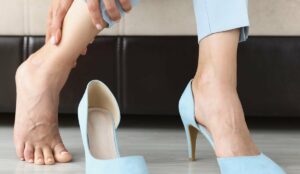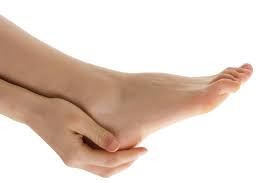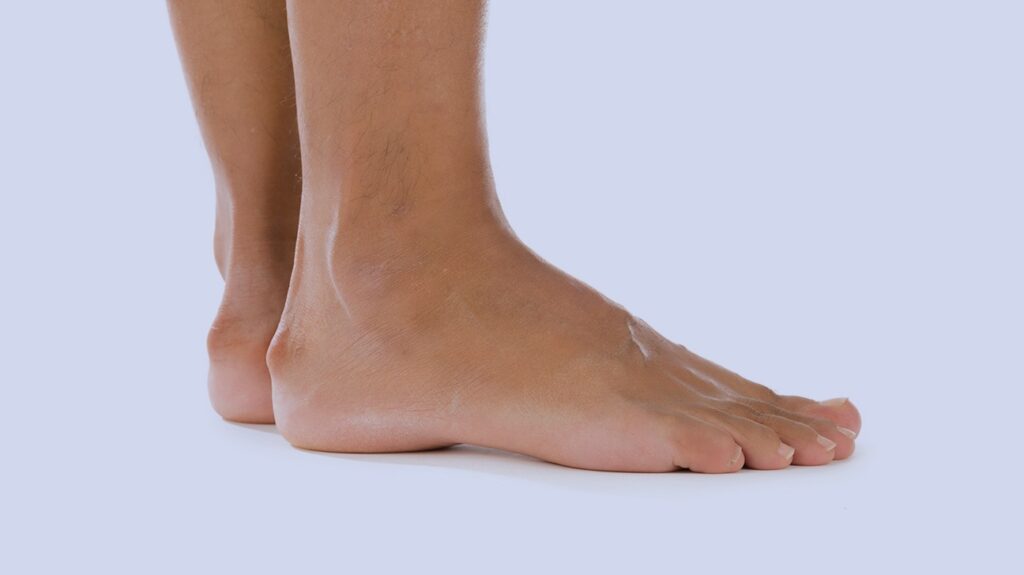Do you have a bump on the back of your heel? You’re not alone! Many people suffer from heel bumps, and there are several reasons why you might develop one. In this blog post, we will discuss the six most common causes of heel bumps and what you can do to get rid of them.
Contents
What Causes Bump On Back Of Heel?
 A bump on back of heel is considered a common injury. It is seen more often in runners, people who are overweight, and those who wear shoes that fit poorly. The condition is also seen in children who are going through a growth spurt. There are several different types of heel bumps, but the most common is known as posterior tibial tendonitis.
A bump on back of heel is considered a common injury. It is seen more often in runners, people who are overweight, and those who wear shoes that fit poorly. The condition is also seen in children who are going through a growth spurt. There are several different types of heel bumps, but the most common is known as posterior tibial tendonitis.
This type of heel bump is caused by the inflammation of the posterior tibial tendon. This tendon is responsible for connecting the calf muscle to the bones in the foot. It also helps to stabilize the arch of the foot. When this tendon becomes inflamed, it can cause a bump on back of heel.
Let’s discuss some more common causes and risk factors of bump on back of heel:
Overuse
One of the most common reasons behind developing a bump on back of heel is overuse. This can occur due to running or participating in other high-impact activities on a regular basis. For example, if you are a runner, you may be more likely to develop this condition due to the repetitive impact that your feet endure every time they hit the ground.
Poorly Fitting Shoes
Another common cause of bump on back of heel is wearing shoes that fit poorly. This can put unnecessary stress on the heel and lead to the development of a painful bump. It is important to make sure that you are wearing shoes that fit properly and provide adequate support for your feet.
Age
It is another risk factor that might cause this condition. For example, if you are a middle-aged woman, you might have this problem due to the hormonal changes that your body is going through. And people who are 40 years old and above are more likely to suffer from heel bumps.
Obesity
Being overweight puts more pressure on your feet, which can cause a heel bump. If you’re struggling with your weight, talk to your doctor about a plan to lose pounds safely. For some people, losing weight may not be enough to get rid of the heel bumps. In this case, you may need orthotics — custom-made shoe inserts — to help distribute your weight more evenly.
Excessive Pronation
Excessive pronation, or flattening of the arch, can also lead to the development of a bump on back of heel. This condition occurs when the foot rolls inward too much when walking or running. This puts extra stress on the heel and can cause the formation of a bone spur. For example if you have a job that requires you to stand on your feet for long periods of time, you may be more susceptible to this condition.
Arthritis
 Arthritis is another common cause of a bump on back of heel. This condition causes the joints to swell and can lead to the formation of bone spurs. There are many different types of arthritis, but the most common type that affects the heel is osteoarthritis. Treatment for this condition typically involves a combination of medication and physical therapy.
Arthritis is another common cause of a bump on back of heel. This condition causes the joints to swell and can lead to the formation of bone spurs. There are many different types of arthritis, but the most common type that affects the heel is osteoarthritis. Treatment for this condition typically involves a combination of medication and physical therapy.
These are a few causes of a heel bump. If you have any concerns, be sure to speak with your doctor or a podiatrist. They will be able to give you a more specific diagnosis and devise a treatment plan that is best for you.
How Does It Feel Like?
Many people with heel bumps complain of pain in the back of their heels. The pain is often more noticeable when they first get out of bed in the morning or after sitting for a period of time. It can also be worse after exercising. The pain is usually a dull ache, but it can become sharp with activity.
It might feel like you’re walking on a pebble in your shoe. Or, it could feel like there’s a knot in the back of your heel. You might even see a lump on the back of your heel. Some common symptoms that people experience include:
- Pain in the back of the heel
- Swelling in the back of the heel
- A lump on the back of the heel
- Redness in the area
- Tenderness to touch
It is important to note that not all heel bumps are painful. You might have a heel bump and not even know it! So, you need to be aware of the symptoms and seek medical attention if you are experiencing any pain.
What Conditions You Might Have With Bump on Back Of Heel?
Well, if you have a bump on the back of your heel, it could be any number of things. For example, you might have a Haglund deformity, bursitis, or even a bone spur. However, before you start to worry too much, it’s important to understand that not all heel bumps are cause for alarm.
Let’s take a look at these conditions in detail:
- Haglund Deformity: This condition is also sometimes referred to as “pump bumps” because it is often seen in women who wear high heels. A Haglund deformity is a bone growth that develops on the back of the heel. This growth can put pressure on the soft tissue in the area and cause irritation.
- Bursitis: Bursitis is another common condition that can cause a bump on the back of your heel. This condition occurs when the bursa, a small fluid-filled sac, becomes irritated. The bursa is located between the bone and the tendon and acts as a cushion. When it becomes irritated, it can swell and cause pain.
- Bone Spurs: Bone spurs are another possible cause of a heel bump. These growths develop when the body attempts to repair itself from an injury or repetitive stress. Spurs can put pressure on the surrounding tissue and cause pain.
So, these might be some of the reasons why you have a bump on the back of your heel. But what can you do about it? Let’s discuss some options to help yourself in this condition!
How To Get Rid Of This?
 When you have a heel bump, it can be really painful and make it hard to walk. You might be wondering what causes this problem and how you can get rid of it. Here are some tips to help get rid of bump on back of heel.
When you have a heel bump, it can be really painful and make it hard to walk. You might be wondering what causes this problem and how you can get rid of it. Here are some tips to help get rid of bump on back of heel.
Wear the right shoes
This is one of the most important things you can do to prevent heel bumps. Make sure you wear shoes that fit well and support your feet. Avoid high heels, flip-flops, and other shoes that don’t offer enough support. Because your shoes or footwear is the number one reason you’re likely to get a heel bump. If you work on your feet all day, make sure to wear comfortable shoes that offer good support.
Use padding
If you have a heel bump, you can use padding to help protect the area and prevent it from getting worse. You can purchase special heel pads or inserts that go into your shoes. Or you can make your own pads out of moleskin, felt, or other materials. Place the padding over the bump and secure it in place with adhesive tape. This will even out the pressure on your heel and help to prevent further irritation.
Choose physical therapy
It is important to see a physical therapist if you are having heel pain. A physical therapist can help you determine the source of your pain and create a treatment plan that will help you feel better. There are several things that a physical therapist can do to help.
First, they will assess your movement patterns and identify any abnormalities. They will also test the strength and flexibility of your muscles and joints. This information will help them create a treatment plan that is specific to your needs. Physical therapists can provide you with exercises to stretch and strengthen your muscles.
See a doctor
If you are having heel pain, the first step is always to see a doctor. They will be able to help you figure out the root of the problem and prescribe the best treatment. Seeing a doctor is an essential part of getting rid of a heel bump. Because they can help you find the source of the problem, and rule out other potential causes of heel pain, such as plantar fasciitis.
Consider surgery
 Surgery is one of the last resorts for treating a heel bump. It’s usually only recommended if the bump is large and painful, and other treatments haven’t worked. The goal of surgery is to remove the part of the bone that’s protruding. This can be done through an incision in your heel or by making a small cut in the back of your Achilles tendon. Surgery carries the risk of complications, such as infection, so it’s usually only recommended if other treatments haven’t worked.
Surgery is one of the last resorts for treating a heel bump. It’s usually only recommended if the bump is large and painful, and other treatments haven’t worked. The goal of surgery is to remove the part of the bone that’s protruding. This can be done through an incision in your heel or by making a small cut in the back of your Achilles tendon. Surgery carries the risk of complications, such as infection, so it’s usually only recommended if other treatments haven’t worked.
Overall, these are just a few ways through which you can get rid of bumps on back of heel. It is important to note that not every treatment will work for every person, so it’s important to talk to your doctor about what’s best for you. With the right treatment, however, you can get rid of the pain and discomfort associated with a heel bump.
Conclusion
In conclusion, the bump on back of heel can be described as a very common condition that can affect people of all ages. If you have a heel bump, it is important to consult with a medical professional to ensure that it is not something more serious. There are a variety of treatments available for heel bumps, and the best course of action will depend on the individual case.
However, in most cases, the bump on back of heel will go away on its own with time and does not require any medical intervention. But if it becomes severe, physical therapy can be a great help. So do not delay in seeking the right help!
Physical Therapy help patients recover from pain. If you’re experiencing Back pain, Shoulder pain, Knee pain, Neck pain, Elbow pain, Hip pain, or Arthritis pain, a physical therapist at MantraCare can help: Book a physiotherapy session.


